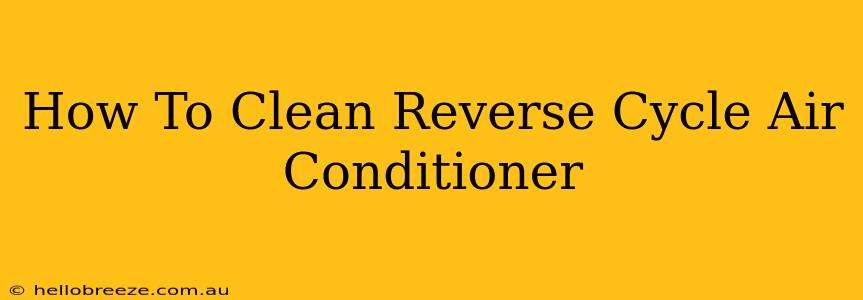Maintaining a clean reverse cycle air conditioner is crucial for optimal performance, energy efficiency, and a healthier home environment. A dirty unit can lead to reduced cooling and heating capacity, increased energy bills, and even potential health problems due to the buildup of dust, mold, and allergens. This comprehensive guide will walk you through the essential steps to effectively clean your reverse cycle air conditioner, both inside and out.
Understanding Your Reverse Cycle Air Conditioner
Before diving into the cleaning process, it's helpful to understand the different components of your reverse cycle air conditioner. These systems typically consist of an outdoor unit (condenser) and an indoor unit (evaporator). Both require regular cleaning, although the methods differ slightly.
Key Components:
- Outdoor Unit (Condenser): This unit releases heat outside your home. It contains a condenser coil, fan, and compressor. Dirt and debris can restrict airflow and reduce efficiency.
- Indoor Unit (Evaporator): This unit is responsible for cooling or heating the air inside your home. It features an evaporator coil, air filter, and fan. Dust, mold, and allergens accumulate here, impacting air quality.
Cleaning Your Reverse Cycle Air Conditioner: A Step-by-Step Guide
Remember to always switch off and unplug your air conditioner before starting any cleaning process. Safety is paramount!
Cleaning the Outdoor Unit (Condenser):
- Clear the Surroundings: Remove any leaves, grass clippings, or debris around the outdoor unit. This ensures proper airflow.
- Hose Down: Use a garden hose with a nozzle to gently rinse away loose dirt and debris from the condenser fins. Avoid using high-pressure water, as this can damage the fins.
- Fin Comb (Optional): For stubborn dirt, a fin comb can help straighten bent fins and improve airflow.
- Let it Dry: Allow the outdoor unit to air dry completely before turning it back on.
Cleaning the Indoor Unit (Evaporator):
- Locate the Air Filter: Consult your air conditioner's manual to locate the air filter. It's usually accessible behind a panel on the unit.
- Remove and Clean the Filter: Gently remove the air filter and vacuum off loose dust and debris. You can also wash it with warm, soapy water and let it air dry completely before replacing it. Replace dirty filters regularly, as recommended by the manufacturer.
- Clean the Evaporator Coils (Advanced): Cleaning the evaporator coils requires more expertise. You can try using a coil cleaning brush or spray, but if you're uncomfortable doing this yourself, it's best to call a qualified HVAC technician.
- Clean the Fan Blades: Carefully clean the fan blades with a soft brush or cloth.
Additional Cleaning Tips:
- Regular Maintenance: Cleaning your air conditioner regularly, ideally every 3-6 months, is vital for optimal performance.
- Professional Cleaning: Consider scheduling a professional cleaning at least once a year, especially if you notice reduced cooling or heating capacity or unusual noises. Professionals have specialized tools and expertise for thorough cleaning and inspection.
- Inspect for Leaks: Always check for any signs of leaks or water damage around the unit.
- Avoid Harsh Chemicals: Never use harsh chemicals or abrasive cleaners, as these can damage the air conditioner's components.
Boosting Your Air Conditioner's Efficiency
Beyond regular cleaning, several other steps can enhance the efficiency of your reverse cycle air conditioner:
- Regular Filter Changes: Replacing the air filter as recommended by the manufacturer is crucial.
- Proper Ventilation: Ensure adequate ventilation around the indoor and outdoor units.
- Annual Maintenance: Schedule an annual service by a qualified technician. This preventative maintenance can identify potential problems before they become major issues.
By following these steps and incorporating regular maintenance into your routine, you can ensure your reverse cycle air conditioner operates efficiently, providing comfortable temperatures and clean air for years to come. Remember, if you’re ever unsure about any aspect of the cleaning process, contacting a qualified HVAC technician is always the safest option.

